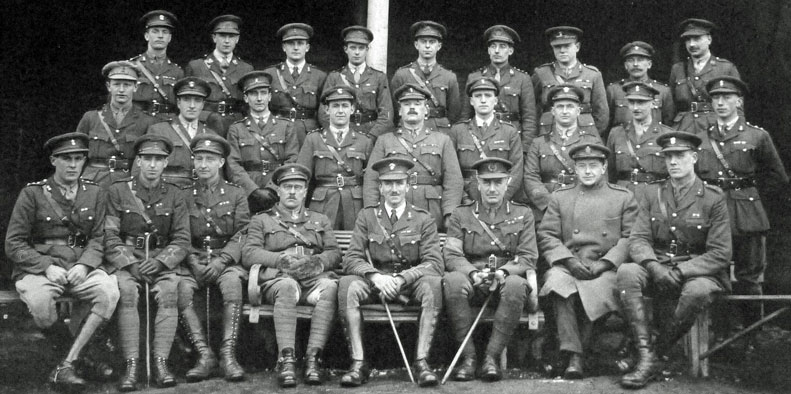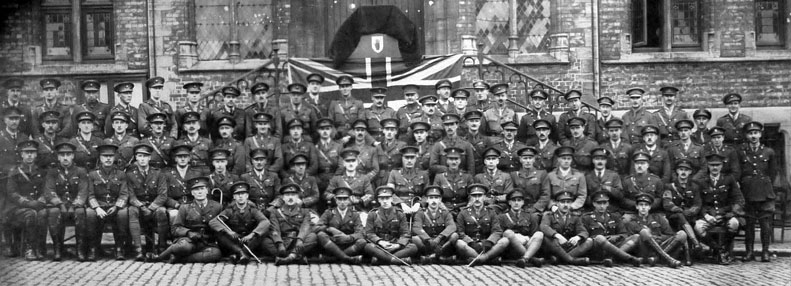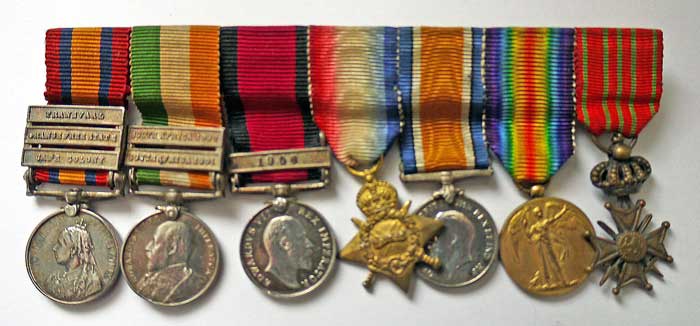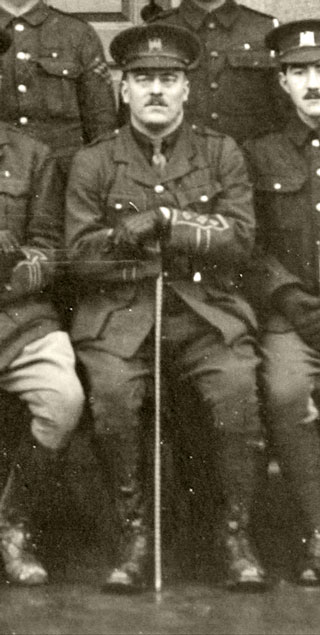Major Adrian Hulse
Adrian Hulse was born on 26 February 1882 at Kensington, London, the fifth of seven children of butler John Hulse and his wife Lucy Jane (née Webb). He grew up with his mother and siblings at the Field Lane Ragged School, Holborn, where his mother was employed as a matron. He was educated at St Clements Grammar School in London.
On 14 February 1901 Hulse enlisted in London in the Duke of Cambridge's Own Imperial Yeomanry (No.34026). He gave his age as 21 (two years more than his true age), his occupation as a clerk, and stated that he was currently serving as a volunteer in the 1st Battalion, Royal Fusiliers. On 9 March 1901 he embarked for South Africa with the 57th (Buckinghamshire) Company, 15th Battalion, Imperial Yeomanry, returning home and being discharged in August 1902. His conduct was recorded as 'very good'. He subsequently returned to South Africa, serving in the Cape Mounted Rifles from 1903 to 1910, returning home at the beginning of 1911. At the time of the 1911 Census he was living with his parents at 10 Alexandra Road, Sydenham. His twin brother Cecil Edward had died in Cape Province in 1908.
Hulse then moved to Malaya, where he worked for Morgan's Agency, a rubber and produce broker, and served in the Malay States Volunteer Rifles from 1912 to 1914.
Soon after the outbreak of war Hulse left Kuala Lumpur for home in order to join up. On 2 November 1914 he applied for a commission in the infantry, with a preference for the 'Ulster Volunteers'. Later that month he was commissioned as a captain and posted to the 16th (Service) Battalion, Royal Irish Rifles. On 8 January 1915, however, he was transferred to the newly-formed 6th (Inniskilling) Dragoons Service Squadron. On 5 October 1915 he embarked for France with the squadron, which was then serving as divisional cavalry to the 36th (Ulster) Division.
The squadron diary includes numerous mentions of Hulse's activities during this period:
12 October 1915: "Capt. Hulse & Sergt Quinn left to attend a Bombing Class."
17 October 1915: "Capt. Hulse & Sergt Quinn returned after the course of Bombing."
20 October 1915: "Eight men per troop selected as Bombers under the instruction of Capt Hulse."
7 December 1915: "Mounted Parade at 8.30 am under Capt. Hulse."
8 December 1915: "A pamphlet on defensive measures against Gas attacks will be read by Capt Hulse."
11 December 1915: "Mounted parade at 8.30 am under Capt. Hulse in conjunction with the 36th Div. Cyclist Coy."
19 December 1915: "The following men are appointed snipers and will train under Capt Hulse ..."
20 December 1915: "Bombing under Capt Hulse at Pontremy."
23 December 1915: "Horses exercised under Capt Hulse."
26 December 1915: "C. of E. parade under Capt Hulse at 10.15 am."
3 January 1916: "The Squadron will march under Capt Hulse to their Billets in new Area."
6 January 1916: "Bombing under Capt Hulse."
23 January 1916: "Divine Service parade under Capt. Hulse for service at Berneuil".
31 January 1916: "Capt. Chamberlayne proceeded on leave to England, and Capt. Hulse assumed command of the Squadron."
27 June 1916: "Nos 2 & 4 Troops under Capt Hulse moved from Toutencourt to Forceville."
In June 1916 the Inniskilling squadron became part of the newly-formed 2nd North Irish Horse Regiment. Hulse took command of the squadron on 13 July that year with the departure of Major Chamberlayne. Within a month, however, he was wounded and returned to Ireland. The Belfast News-Letter of 23 November 1916 reported that he:
... visited Enniskillen last week on a visit to Captain G. H. Moorhead, who is in command of the Reserve of the Squadron. Captain Hulse received a warm welcome from his old friends, and while in Enniskillen delivered a lecture to the men of the Reserve Squadron on warfare and tactics in France.
Hulse returned to the front before the end of the year – the regimental diary recording his activities:
9 December 1916: "The usual trench digging party was in charge of Capt. Hulse".
27 December 1916: "Usual digging party under Capt Hulse."
4 January 1917: "Capt Hulse was in charge of working party which was shelled but no casualties occured."
2 February 1917: "Capt Hulse was in command of trench digging party and reports all quiet."
13 February 1917: "Capt Hulse was in command of usual Trench party."
22 March 1917: "Trench Digging party under Capt Hulse all quiet."
On 1 April at Boeschepe he fell ill with sciatica. Evacuated to England, he was admitted to the 2nd London General Hospital. A medical board reported that he had:
... developed pain in the right loin & buttock which afterwards shifted to the left side. The pain he had on coughing & when walking about has now disappeared. His general health is good.
Hulse was sent on three weeks' leave. On 11 June a medical board at Croydon War Hospital found him fit for general service, and on 7 July he rejoined his squadron in France.
In September 1917 the 2nd NIH Regiment was disbanded and most of its officers and men, including those of the 6th (Inniskilling) Dragoons Service Squadron, were transferred to the infantry, the majority to the 9th (Service) Battalion, Royal Irish Fusiliers. Hulse found the physical demands of infantry traning difficult. A medical board at Le Havre on 27 September reported that:
... he is somewhat fat and finds physical training difficult. He is however organically sound and desirous of proceeding to the front and the Board considers him fit for general service.
Posted to the 9th (Service) Battalion, he reporting for duty on 6 October. However on 16 November he was attached to the 9th (Service) Battalion, Royal Inniskilling Fusiliers. He served as Town Major of Artemps from 6 February to 21 March 1918 before returning to the Inniskilling Fusiliers battalion. In July he was sent to a senior officers’ course at Aldershot, returning to France in September. After serving in various roles with the Inniskilling Fusiliers, on 15 December 1918 he was promoted to the rank of major. In January 1919 he was awarded the Belgian Croix de Guerre.
Hulse contracted influenza in January 1919. He was later hospitalised, a medical board at Etaples on 24 March finding he was suffering from "post influenzal debility, and recommending three weeks' leave in England. He was demobilised on 30 April that year. On 22 October 1920 he relinquished his commission, having first applied to be included on the Reserve of Officers. This was subsequently approved at the rank of major, with seniority from 8 December 1920.
On 14 June 1919 he married hotel proprietor's daughter Mary Alice Papps in the Sutton-cum-Seaford Parish Church, Sussex.
On 19 January 1921 Hulse joined the Royal Irish Constabulary's Auxiliary Division (No.1573) – otherwise known as the Black & Tans. Initially posted to O Company, on 23 February he was posted to C Company as company commander. On 19 April he was shot in the chest while on patrol:
At about 9 p.m. on 19th of April 1921 a convoy of Auxiliary police was ambushed and bombed in Sandford Road, Ranelagh, Dublin. The police left their motor cars and proceeded to search the houses and surroundings. T/Cadet Major Hulse and another cadet entered No.8 Sandford Terrace through the front. He proceeded to the back and was in the act of opening the back gate of the garden when he was fired at and wounded in the chest by T/Cadet Ring who, with two other cadets was searching the passage at the back of the terrace. The occurrence was due to T/Cadet Ring, in the excitement of the moment, mistaking his comrades for a hostile party. A Court of Inquiry, held at Portobello Barracks on 25th April 1921, found that the wounding of Major Hulse was caused through no fault or negligence of himself or T/Cadet Ring.
Hulse was later awarded £1400 compensation under the Criminal Injuries (Ireland) Acts.
After time in hospital and on medical leave, on 22 September he was posted as company commander of A Squadron. He was discharged when the Auxiliaries were demobilised on 30 January 1922.
On 26 February 1932 he was discharged from the Reserve of Officers, having reached the age limit – fifty years.
At the time of the 1939 Register, Hulse and his wife were living at 6 Union Street, Bedford, he working as a temporary clerk at RAF Cardington. On the outbreak of war he had enrolled in the Officers’ Emergency Reserve.
He died in Leicester in 1964.

Hulse, front row fourth from left, with officers of the Royal Inniskilling Fusiliers.

Hulse, second row third from right, with surviving original officers of the 36th (Ulster) Division on Armistice Day 1918.

Hulse's medals
The first image, part of a group photo of officers and NCOs of the squadron, appeared in the Belfast Evening Telegraph on 28 January 1915. The full image can be seen here. Some of the information about the Auxiliaries was sourced from the website The Auxiliary Division of the Royal Irish Constabulary. The other images are sourced from the Imperial War Museum's website Lives of the First World War – contributor 'Brian8102.
This page last updated 17 October 2023.

